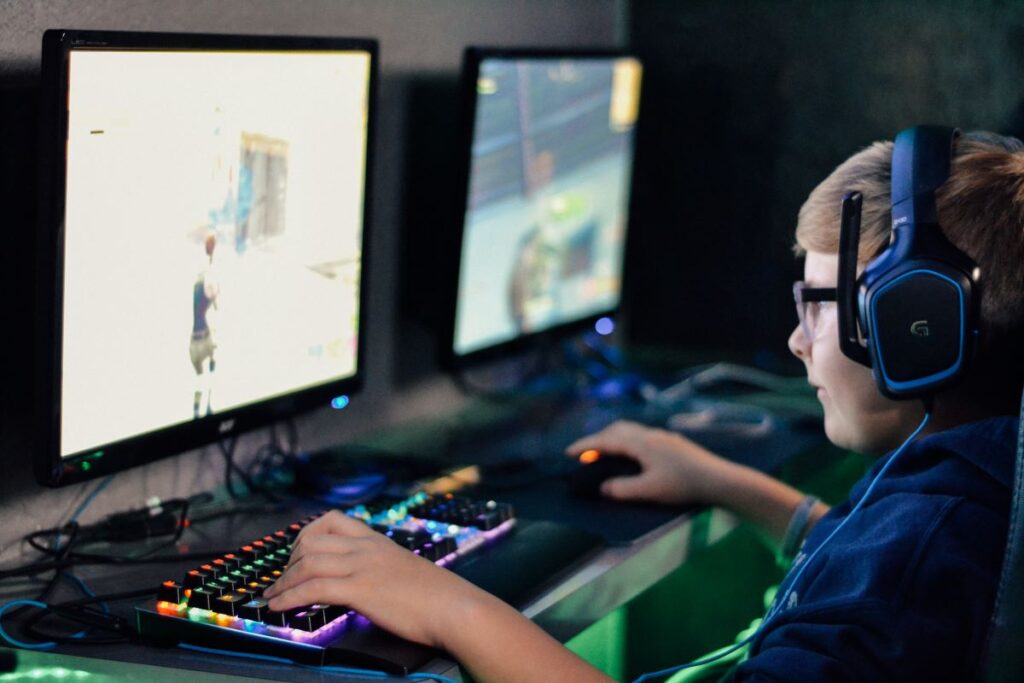
Depression and anxiety are highly debilitating mental illnesses commonly reported among young people (Baker, 2020). These disorders can lead to lower academic achievement, unemployment and reduced social support, just to name a few (Fergusson & Woodward, 2002). However, much research has demonstrated the positive impact that psychological therapy, most notably cognitive behavioural therapy (CBT), can have on depression and anxiety symptoms (National Institute for Health and Care Excellence [NICE], 2019).
However, there are many barriers to accessing such treatment, for example, long waitlists and stigma attached to receiving help (Radez et al., 2021). Therefore, research has been interested in seeing whether other more scalable forms of psychological treatments could effectively treat depression and anxiety in young people. One intervention that has generated increasing attention over the last few years is serious gaming. This could potentially be a promising avenue as, in the UK, 81% of 12 to 15-year-olds play games on various devices (Ofcom, 2020).
Some examples of gaming interventions used to support individuals manage their mental health include virtual reality, which uses computer-generated simulations of an environment where individuals can interact. Also, CBT games integrate tools and techniques to help people manage their symptoms.
A recent study by Christopher Townsend and colleagues (2021) examined the effectiveness of gaming interventions on depression and anxiety among young people by combining results from various independent research articles.

This study integrated evidence to examine the effectiveness of gaming interventions for treatment of young people’s depression and anxiety.
Methods
The following databases were used to identify relevant studies: PsycINFO, ISI Web of Science Core Collection, Medline, and EMBASE.
Inclusion criteria for experimental studies:
- sample aged 12-25 years old,
- presence of a gaming intervention for anxiety and/or depression,
- depression and/or anxiety to be the primary outcomes assessed either by validated outcome or diagnostic interviews at baseline and post-intervention,
- randomised controlled trial (RCT) or non-RCT design,
- published in English,
- published in peer-reviewed journals.
An intervention was considered a ‘gaming intervention’ if it met the following criteria:
- designed for recreational use,
- being interactive and/or competitive,
- presence of a system of reward, incentive, and/or objective.
The quality and the risk of bias of studies were assessed using version 2 of the Cochrane Collaboration risk-of-bias tool for RCTs and the Risk of Bias in Non-Randomized Studies of Interventions (ROBINS-I) assessment tool for non-RCTs. Data were analysed using a meta-analysis approach separated by study design, i.e., RCTs, between-sample comparison designs, and repeated measures designs.
Results
Seven RCTs and five non-RCTs were identified and included in the final analysis.
Study characteristics
The included RCTs had a total of 844 participants (age range: 13.02 to 22.34 years), whilst the non-RCTs had 359 participants (age range: 12.88 and 20.60 years). Of the five non-RCTs, two adopted a between-samples design, and three followed a repeated measures design. Ten out of the twelve studies had a sample size smaller than 100 participants. The measures used to assess depression and/or anxiety differed considerably. SPARX was the gaming intervention primarily implemented, whereby users learned CBT-based skills to explore a fantasy game world.
Risk of bias
Five of the seven RCTs were assessed as having a low risk of bias whereas all non-RCTs were rated as moderate risk. Two common sources of bias which studies fell down on were in selecting the reported result and selection of participants. Four of the five non-RCTs had potential participant-selection biases, whilst all of them had selective reporting biases.
Meta-analysis
- The RCTs demonstrated that gaming interventions had a medium effect on positively treating depression.
- Whilst the two between-participants non-RCTs did not show gaming interventions to effectively treat depression.
- Furthermore, both RCTs and the two between-participants non-RCTs showed that gaming interventions did not have a significant impact on anxiety symptoms.

The findings of this meta-analysis demonstrate that gaming interventions have the potential to treat depression in young people.
Conclusions
This recent systematic review and meta-analysis brings together evidence suggesting that gaming interventions may be an effective treatment for depression in teenagers and young adults. However, no such evidence was found for anxiety. Further studies are warranted to explore the factors underlying the effectiveness of gaming interventions which can provide more clarity on the utility, acceptability, and effectiveness of gaming interventions in treating depression.

According to this review, gaming interventions show promise in treating depression, but we need to know more and how they can be best used with young people.
Strengths and limitations
This is the first systematic review and meta-analysis on this topic, where researchers extensively searched and combined independent studies. Thus, providing a reasonably up-to-date understanding of the effectiveness of gaming interventions on young people’s depression and anxiety.
However, there are some downfalls in the present study. The issue of publication bias is present in this article as researchers only considered studies which were published in a peer-reviewed journal. The validity of this meta-analysis may have been enhanced if the researchers also recognised unpublished articles. Also, although gaming interventions were clearly defined by the authors, there was a lot of difference in the intervention descriptions. Some were points earned through completion of trials, and others were navigating through a fantasy game world. This demonstrates the heterogeneity of the studies included in the review, thus making it unclear what the likely active ingredients of the gaming interventions are.
Furthermore, the authors intentionally did not include any active controls as a comparison, e.g., other games or therapies, but focused on waitlist or care-as-usual as control conditions. Research shows that participants in waitlist or care-as-usual controls tend to improve less than in active control conditions (Guidi et al., 2018), which may have inflated the effect sizes reported. Moreover, the two studies with a sample size greater than 100 reported much smaller effect sizes than the rest. Furthermore, even though no significant baseline differences were reported, none of the studies assessed the participants’ credibility and expectations pre-intervention. The latter could provide an estimation of a potential placebo effect which may have further inflated the reported effect sizes.

Although this is pioneering research, there are methodological downfalls, such as publication bias and heterogeneity across studies.
Implications for practice
The National Health Service (NHS) struggles to effectively support young people with mental health difficulties due to a lack of resources and limited funding. Theo and I (Andie) have seen this first hand working for Improving Access to Psychological Therapies (IAPT) services where clients must often wait anywhere between six to thirteen weeks until they are provided CBT. This study has demonstrated that although gaming interventions are not currently recommended for depression among young people by the NICE guidelines, they could potentially be offered as a stand-alone treatment. This is a promising new avenue which could alleviate the current high demand for other psychological modalities (i.e., traditional CBT).
This is not to suggest that CBT, and other effective psychological therapies (i.e., interpersonal psychotherapy), are redundant. Rather, we suggest that policymakers and clinical leads of mental health services should consider equally viable treatment methods to help young adults manage symptoms of depression. The hope is that this will provide young people with better outcomes, including higher educational achievement, increased social support and an overall better quality of life.

Gaming interventions could potentially be an effective and more accessible treatment to support young people manage their depression.
Statement of interests
None.
Links
Primary paper
Townsend, C., Humpston, C., Rogers, J., Goodyear, V., Lavis, A., & Michail, M. (2022). The effectiveness of gaming interventions for depression and anxiety in young people: systematic review and meta-analysis. BJPsych Open, 8(1).
Other references
Baker, C. (2020). Mental health statistics for England: prevalence, services and funding. (https://dera.ioe.ac.uk/34934/1/SN06988%20%28redacted%29.pdf).
Fergusson, D. M., & Woodward, L. J. (2002). Mental health, educational, and social role outcomes of adolescents with depression. Archives of General Psychiatry, 59(3), 225-231.
Guidi, J., Brakemeier, E. L., Bockting, C. L., Cosci, F., Cuijpers, P., Jarrett, R. B., … & Fava, G. A. (2018). Methodological recommendations for trials of psychological interventions. Psychotherapy and psychosomatics, 87(5), 276-284.
National Institute for Health and Care Excellence (2019). Depression in Children and Young People: Identification and Management [NICE Guideline No. NG134]. https://www.nice.org.uk/guidance/ng134
Ofcom, U. K. (2019). Children and parents: Media use and attitudes report 2018. Ofcom website. (https://www.ofcom.org.uk/__data/assets/pdf_file/0023/190616/chil-dren-media-use-attitudes-2019-report.pdf)
Radez, J., Reardon, T., Creswell, C., Lawrence, P. J., Evdoka-Burton, G., & Waite, P. (2021). Why do children and adolescents (not) seek and access professional help for their mental health problems? A systematic review of quantitative and qualitative studies. European Child & Adolescent Psychiatry, 30(2), 183-211.
Photo credits
- Photo by Igor Karimov 🇺🇦 on Unsplash
- Photo by Ben den Engelsen on Unsplash
- Photo by micheile dot com on Unsplash
- Photo by Kelly Sikkema on Unsplash
- Photo by Pawel Czerwinski on Unsplash
- Photo by Alex Haney on Unsplash
